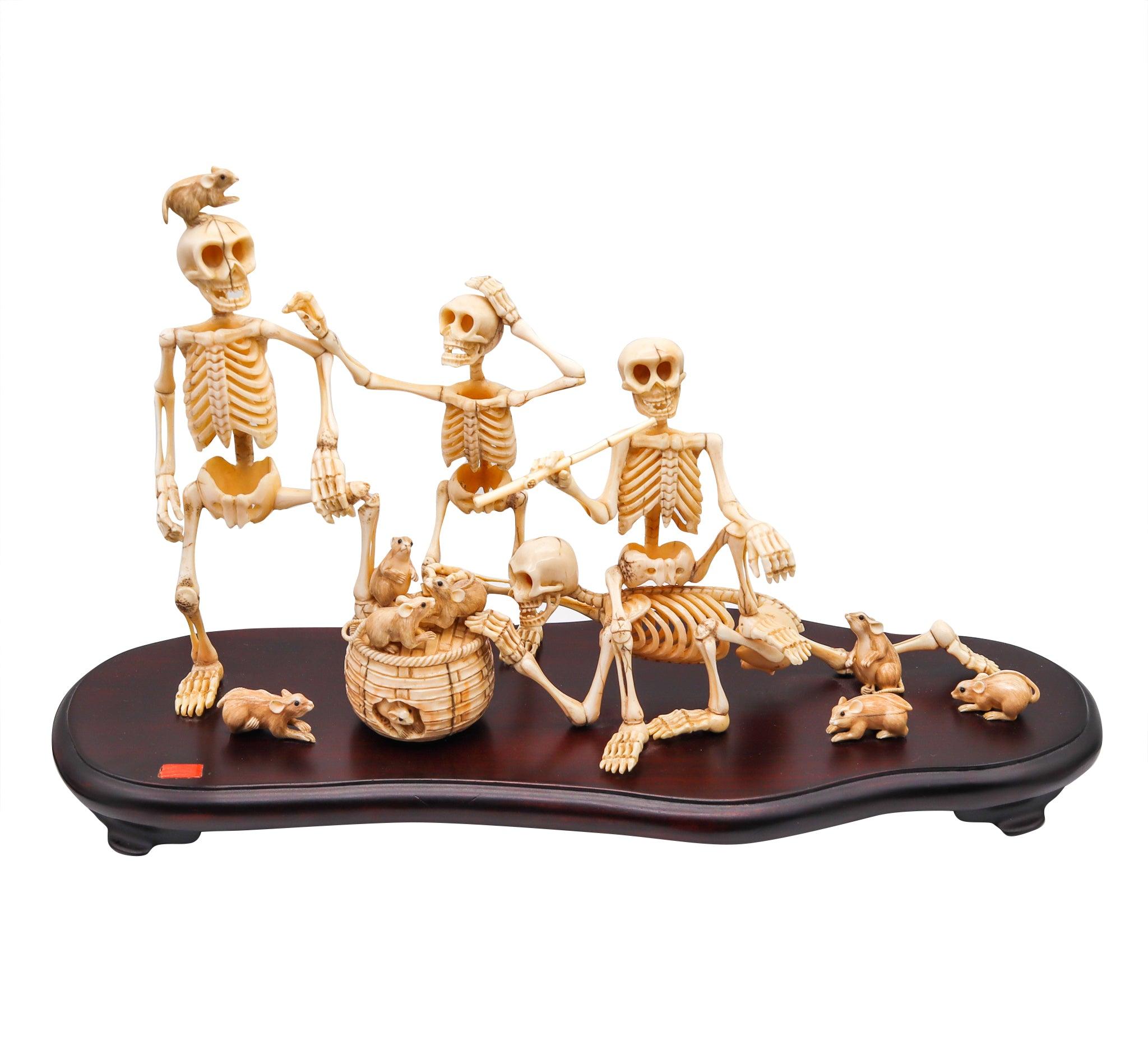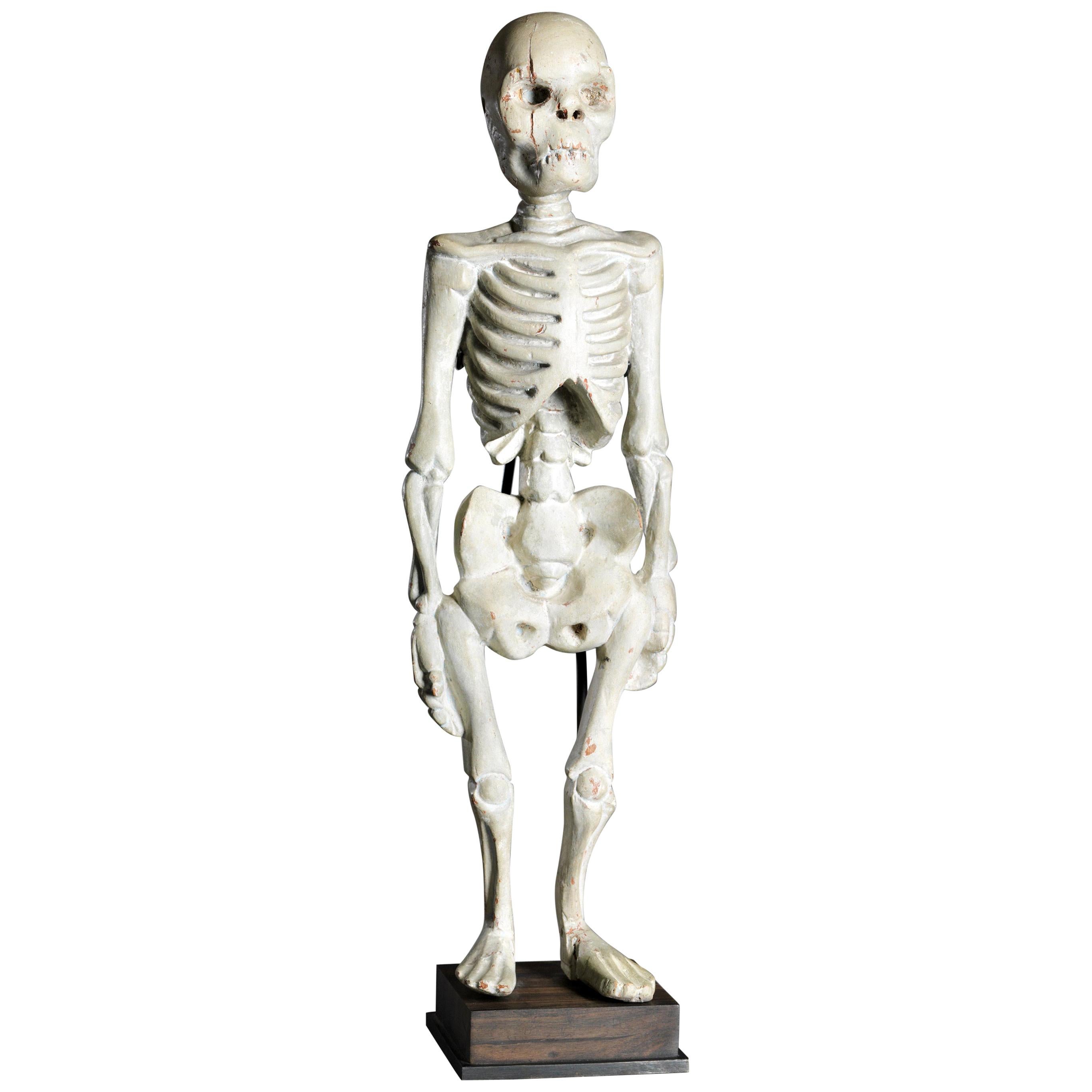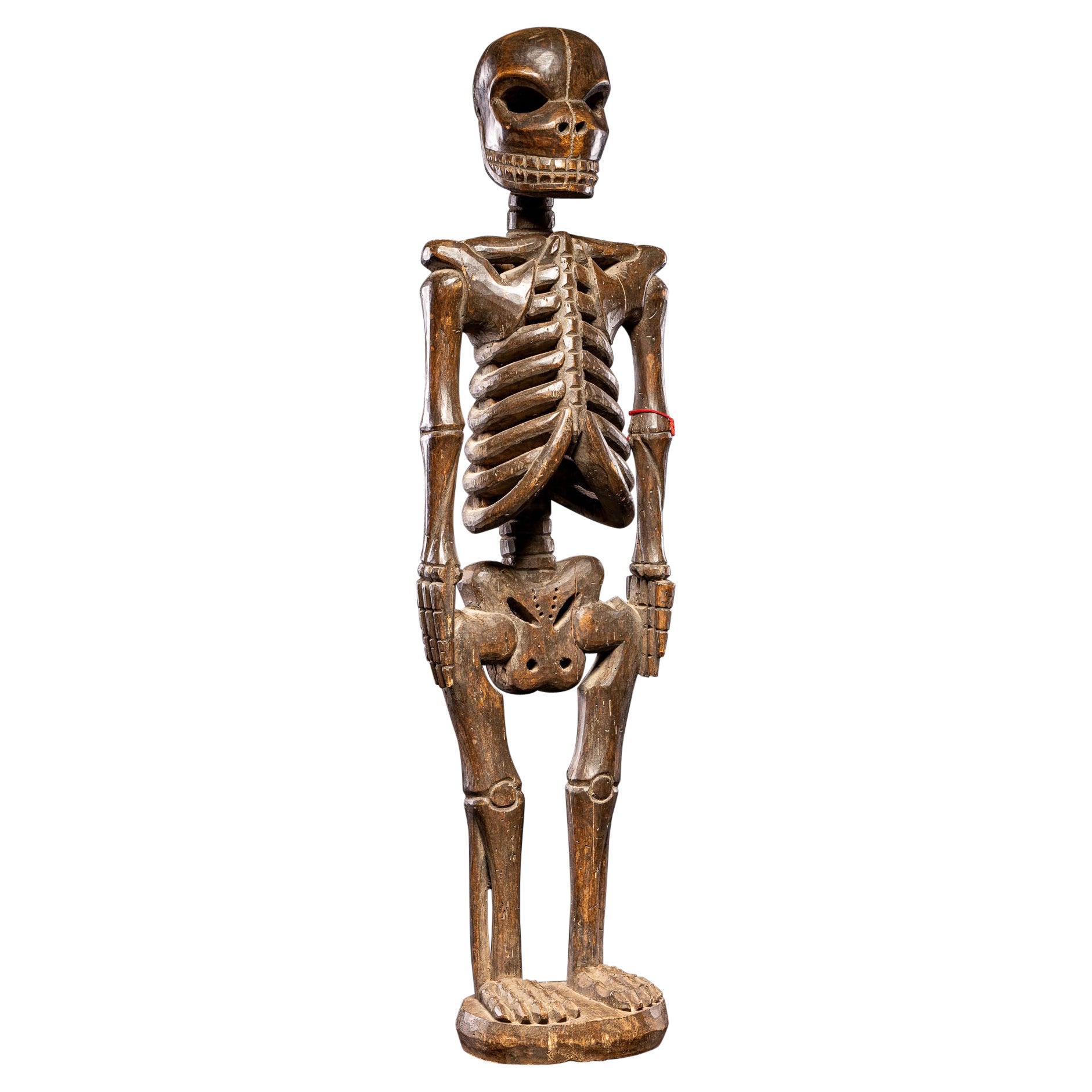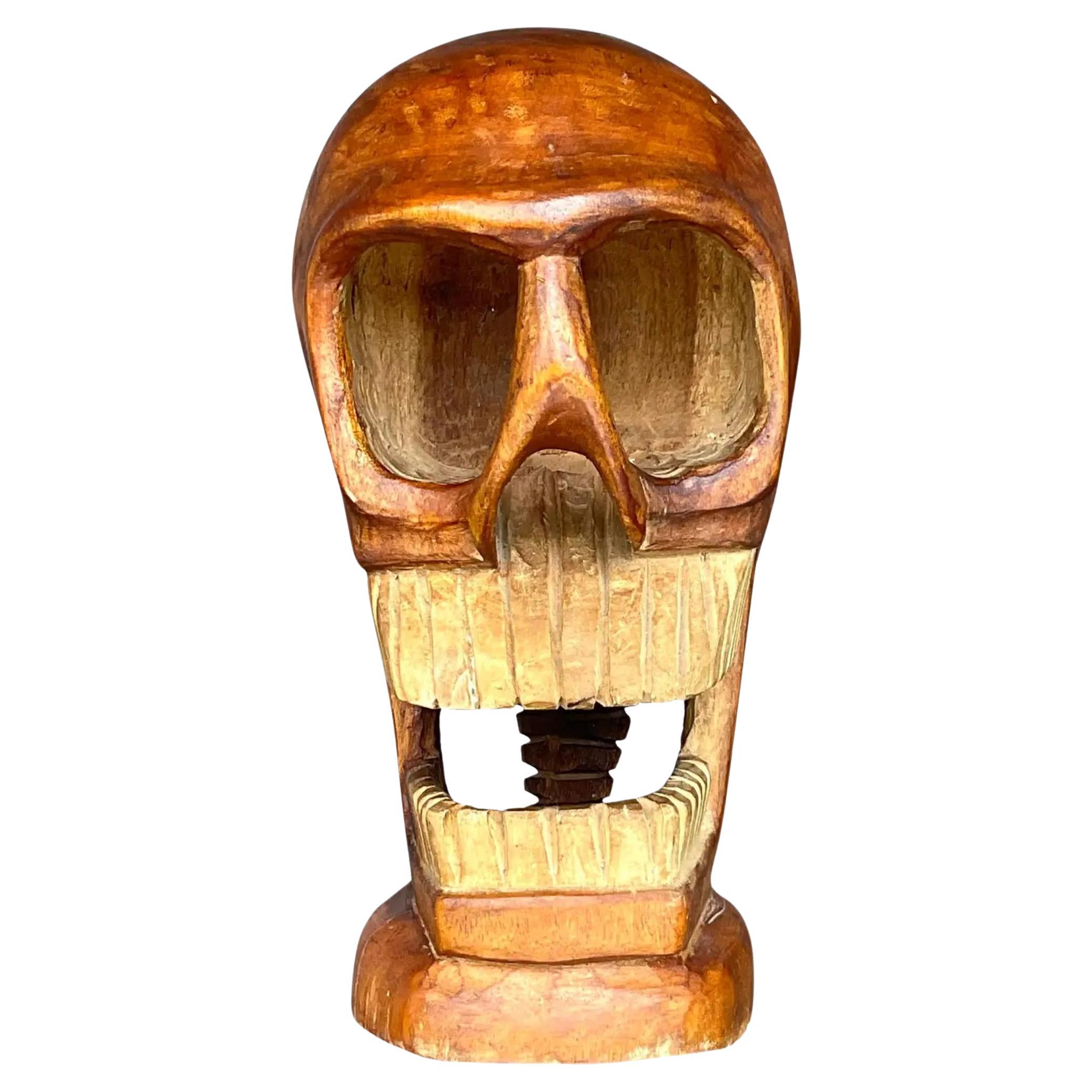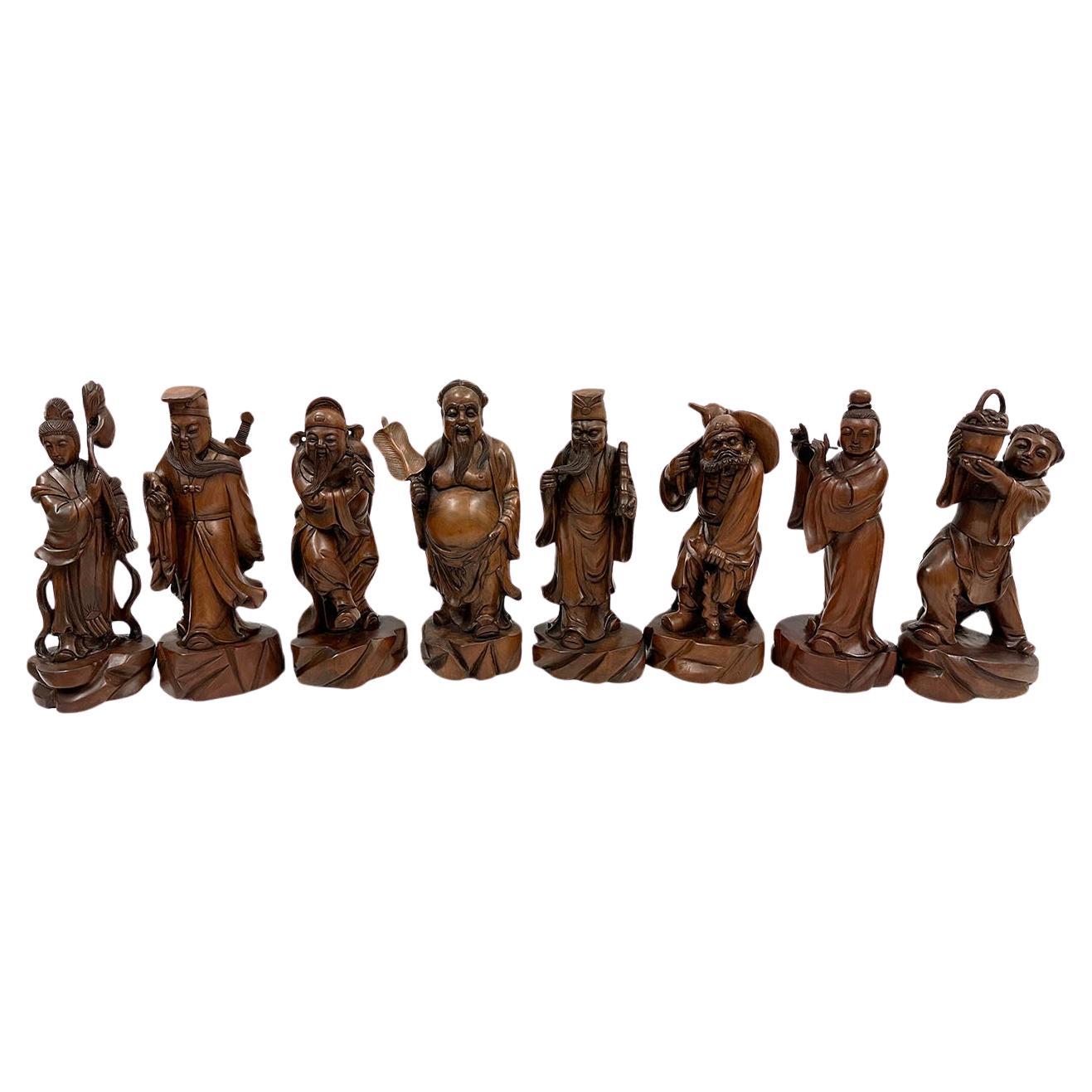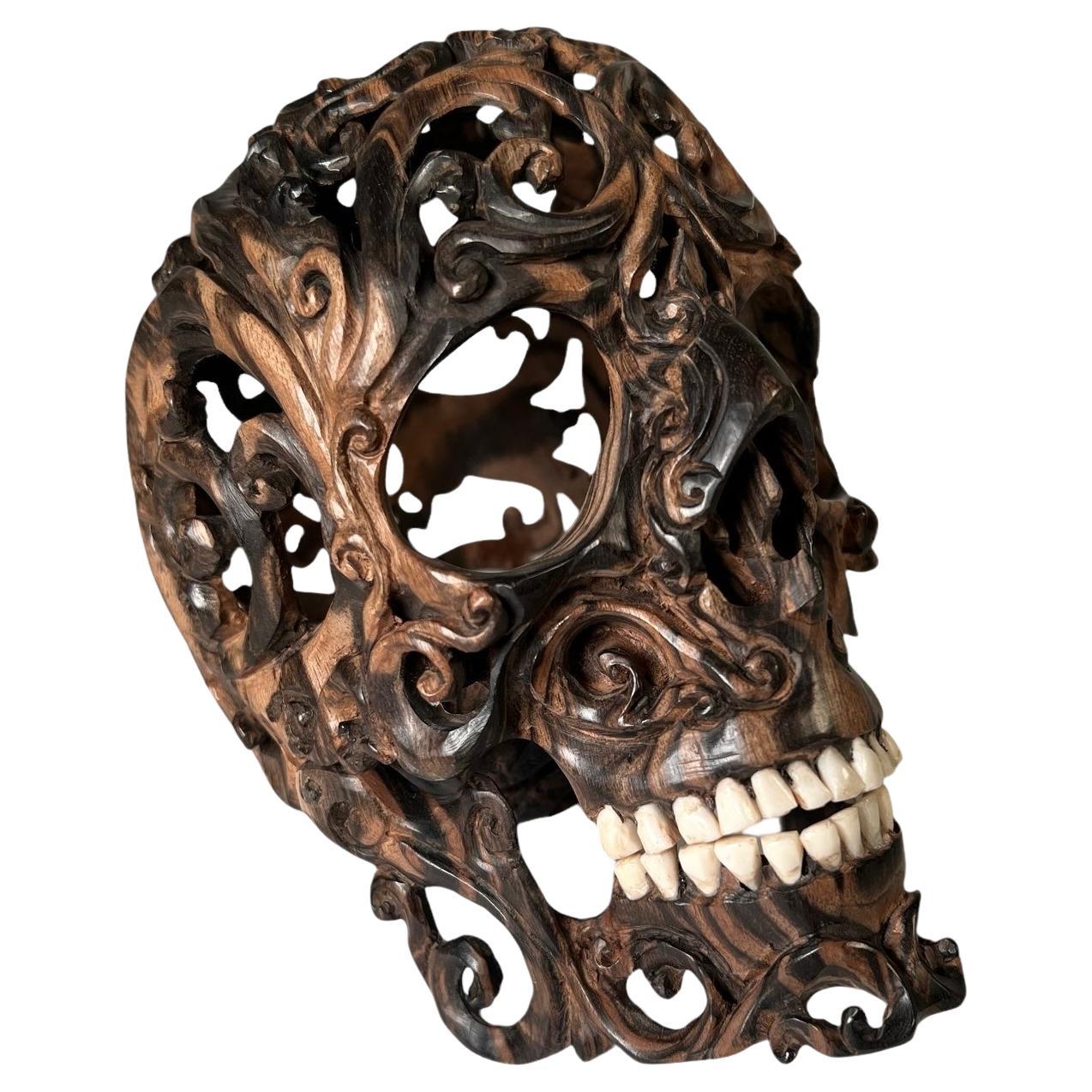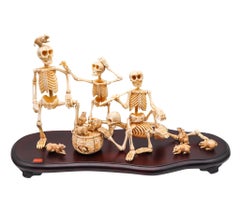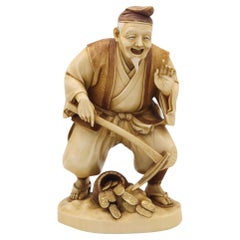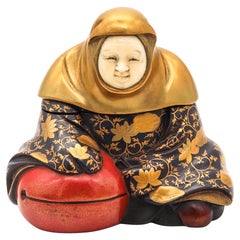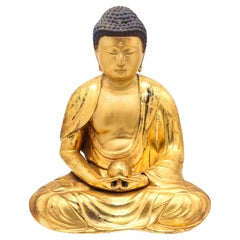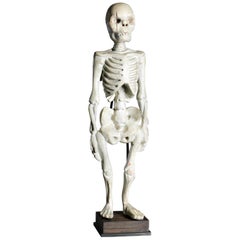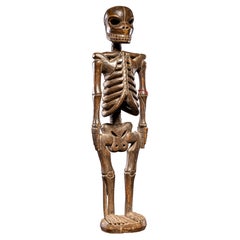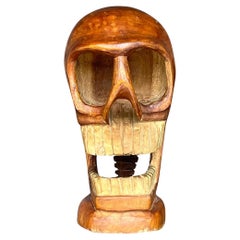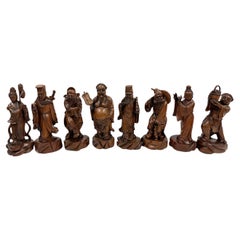Articles similaires à Sculpture Okimono d'un groupe de squelettes fumant, période Meiji, 1890
Vous voulez plus d'images ou de vidéos ?
Demander au vendeur plus d'images ou de vidéos
1 sur 12
Sculpture Okimono d'un groupe de squelettes fumant, période Meiji, 1890
13 008,79 €
17 345,06 €25 % de remise
À propos de cet article
Okimono sculptural signé de la période japonaise Meiji (1868-1912).
Très rare, inhabituel et grand assemblage sculptural d'une pièce de dysplaying okimono. Créé au Japon pendant la période impériale de Meiji (1868-1912). Cet extraordinaire okimono a été soigneusement sculpté pour représenter un groupe de trois squelettes (Gaikotsu) s'amusant de manière complexe et réaliste, en position de détente et de repos, buvant et fumant. Deux d'entre eux, probablement des représentations masculines, se reposent sur un canapé en osier. La troisième est une femme assise sur un tabouret inférieur qui offre des coupes de saké sur un plateau rond. Un petit banc rectangulaire est disposé dans la scène.
La composition est présentée sur une plate-forme en bois sculpté à quatre pattes, avec une plaque rouge incrustée, gravée de la signature de l'artiste. Le niveau de détail et la qualité de la sculpture sont vraiment exceptionnels.
Dimensions exactes : 209,55 mm x 196,85 mm x 127,76 mm (8,25 x 7,75 x 5,03 pouces).
Après une vaste collecte de données, de comparables et de références à cette pièce, nous n'avons pu trouver que trois sculptures d'okimono comme celle-ci avec des thèmes similaires et la même qualité de travail.
Références Note : Une sculpture similaire de quatre squelettes jouant une partie animée de dominos, signée Shutaro dans une plaque rectangulaire rouge incrustée, a été vendue à Londres par Christie's South Kensington le 14 octobre 2014, lot 120 vente 5546.
Références Note : Une sculpture similaire avec quatre squelettes dans une scène victorienne par ailleurs typique d'un photographe et de trois sitters signée Shutaro dans une plaque rectangulaire rouge incrustée, a été vendue à Édimbourg chez Lyon & Turnbull le 7 novembre 2018.
Références Note : Une sculpture similaire représentant cinq squelettes assis, jouant aux cartes et buvant, a été vendue à Londres par John Nicholson Fine Art le 26 septembre 2018.
Période Meiji
L'ère Meiji est la première moitié de l'Empire du Japon, lorsque le peuple japonais est passé d'une société féodale isolée, menacée de colonisation par les puissances occidentales, au nouveau paradigme d'un État-nation moderne et industrialisé et d'une grande puissance émergente, influencée par les idées scientifiques, technologiques, philosophiques, politiques, juridiques et esthétiques de l'Occident. L'adoption massive d'idées radicalement différentes a entraîné de profonds changements au Japon, qui ont affecté sa structure sociale, sa politique intérieure, son économie, son armée et ses relations extérieures. Cette période correspond au règne de l'empereur Meiji. Elle a été précédée par l'ère Keiō et a été remplacée par l'ère Taishō, après l'accession de l'empereur Taishō.
Okimono
Terme japonais désignant un ornement, un objet d'art ou un objet décoratif, généralement exposé dans un tokonoma ou un butsudan, "autel bouddhiste". Il s'agit d'un ornement ou d'une figure, notamment placé dans une chambre d'amis. Un okimono peut être une petite sculpture japonaise, similaire mais plus grande qu'un netsuke. Contrairement au netsuke, qui avait une fonction spécifique, l'okimono est exclusivement décoratif et était exposé dans le tokonoma. Pendant la période Meiji, de nombreux okimonos ont été fabriqués pour être exportés vers l'Occident.
Gaikotsu, qui signifie squelette, apparaît souvent dans les anciens mythes japonais et les dessins de Youkai. Les squelettes ne comportant que des os humains sont appelés "sharekoube". D'autres Youkai célèbres, basés sur des squelettes, sont Gasha Dokuro, Honeonna et Kyoukotsu.
Note importante : En ce qui concerne l'écaille de tortue ou l'ivoire anciens, nous sommes de fervents partisans de la protection des espèces en voie de disparition dans notre monde moderne. Nous n'achetons ni ne vendons jamais d'objets vieux de 100 ans ou plus, nous ne chassons pas, sachant que ces mesures protègent également les animaux qui vivent aujourd'hui à l'état sauvage. Nous reconnaissons également la vaste histoire culturelle que nous préservons en prenant soin de ces objets anciens et en les Rever, et nous sommes d'accord avec les citations selon lesquelles les objets de plus de 100 ans n'ont absolument rien à voir avec l'appauvrissement des espèces dans notre monde actuel.
Condit : L'état général de cette pièce est exceptionnel avec aucune pièce manquante ou cassée, ne présentant même pas de restauration. Cette pièce a été soigneusement inspectée pour garantir son état et son authenticité.
INVENTAIRE REF : D012625ACEM/.8934
- Dimensions:Hauteur : 19,69 cm (7,75 po)Largeur : 20,96 cm (8,25 po)Profondeur : 12,83 cm (5,05 po)
- Style:Meiji (De la période)
- Matériaux et techniques:
- Lieu d'origine:
- Période:
- Date de fabrication:1890
- État:Usure conforme à l'âge et à l'utilisation. L'état général de cette pièce est exceptionnel et ne présente aucune pièce manquante ou cassée, ni même de restauration. Cette pièce a été soigneusement inspectée pour garantir son état et son authenticité.
- Adresse du vendeur:Miami, FL
- Numéro de référence:Vendeur : D012625ACEM/.89341stDibs : LU8303243370192
À propos du vendeur
5,0
Vendeur Or
Vendeurs premium dont la note est supérieure à 4,3 et le délai de réponse de 24 heures maximum
Vendeur 1stDibs depuis 2023
222 ventes sur 1stDibs
Temps de réponse habituel : 2 heures
- ExpéditionRecherche du devis...Expédition depuis : Miami, FL
- Politique des retours
Certaines parties de cette page ont été traduites automatiquement. 1stDibs ne garantit pas l'exactitude des traductions. L'anglais est la langue par défaut de ce site web.
Garantie d'authenticité
Bien qu'il soit peu probable que la situation se présente, dans le cas où vous rencontreriez un problème d'authenticité d'un article, contactez-nous dans un délai d'un an pour obtenir un remboursement intégral. DétailsGarantie de remboursement
Si votre article n'est pas conforme à la description, est endommagé pendant le transport ou ne vous est pas livré, contactez-nous sous 7 jours pour obtenir un remboursement intégral. DétailsAnnulation sous 24 heures
Vous disposez d'un délai de 24 heures pour annuler votre achat sans motif.Des vendeurs professionnels agréés
Nos vendeurs de renommée mondiale doivent respecter des normes strictes en matière de service et de qualité, afin de préserver l'intégrité de nos fiches produit.Garantie d'alignement des prix
Si vous constatez qu'un autre vendeur a mis en vente le même article à un prix inférieur sur un autre site, nous nous alignerons sur ce prix.Livraison en toute confiance à l'international
Notre réseau de transporteurs de premier ordre propose des options d'expédition spécialisées dans le monde entier, y compris des livraisons personnalisées.Plus d'articles de ce vendeur
Tout afficherSculpture Okimono de la période Meiji 1890 avec un groupe de squelettes jouant
Okimono signé de la période japonaise Meiji (1868-1912).
Très rare, inhabituel et grand assemblage sculptural d'une pièce de dysplaying okimono. Créé au Japon pendant la période imp...
Catégorie
Antiquités, années 1890, Japonais, Meiji, Sculptures et objets ciselés
Matériaux
Bois, Laque
13 008 € Prix de vente
25 % de remise
Figure sculptée Meiji du dieu des Fortunes Daikoku en tant que fermier avec des pièces, Japon, 1890
Sculpture japonaise de Daikoku.
Magnifique sculpture du dieu de la fortune Daikoku VIEILLE DE PLUS DE 100 ANS, créée au Japon pendant la période Meiji, vers 1890. La sculpture repré...
Catégorie
Antiquités, années 1890, Japonais, Meiji, Sculptures et objets ciselés
Matériaux
Or
3 244 € Prix de vente
25 % de remise
KAZUYOSHI Japon Meiji 1890 Boîte en bois laqué et doré drapée pour femmes assises
Boîte laquée Meiji en forme de dame assise, réalisée par Meigetsusai Kazuyoshi.
Il s'agit d'une boîte décorative extrêmement rare en forme de personnage assis et habillé tenant une ...
Catégorie
Antiquités, années 1890, Japonais, Meiji, Sculptures et objets ciselés
Matériaux
Feuille d'or
3 244 € Prix de vente
25 % de remise
Sculpture de Bouddha assis en bois massif sculpté et doré de la période Edo 1825 au Japon
Sculpture de Bouddha assis en bois sculpté et doré de la période Edo.
Il s'agit d'une figure en bois sculpté superbement raffinée représentant un bouddha assis, avec une fabuleuse d...
Catégorie
Antiquités, années 1820, Japonais, Edo, Sculptures et objets ciselés
Matériaux
Or
2 278 € Prix de vente
25 % de remise
Statue de Bouddha du 20e siècle en porcelaine Zeng longue marque de griffe République chinoise
Bouddha assis en porcelaine de la République de Chine.
Il s'agit d'une magnifique figurine de dévotion ancienne représentant un Bouddha heureux assis, créée en République de Chine a...
Catégorie
Vintage, années 1920, Chinois, Exportation chinoise, Sculptures et objet...
Matériaux
Émail
649 € Prix de vente
25 % de remise
JAPON 1880 Meiji Canne à pied très détaillée avec des singes dans une forêt de bambous
Canne à pêche de la période Meiji (1868-1912).
Il s'agit d'une fabuleuse canne ancienne créée au Japon impérial pendant la période Meiji (1868-1912), vers les années 1880. La canne ...
Catégorie
Antiquités, années 1880, Japonais, Meiji, Sculptures et objets ciselés
Matériaux
Bois
3 157 € Prix de vente
25 % de remise
Suggestions
Squelette humain debout sculpté en bois, Asie du Sud-Est
La sculpture date du début du 20e siècle et présente une magnifique patine.
Catégorie
Début du 20ème siècle, Birman, Sculptures - Figuratif
Matériaux
Bois
Skeleton cérémoniel en bois dur provenant d'une seule pièce de bois, Nigeria.
Une forme peu commune, la figure abstraite à la bouche remplie de dents se tient droite sur une base intégrale.
Catégorie
20ième siècle, Nigérian, Sculptures - Figuratif
Matériaux
Bois de feuillus
Sculpture de crâne bohème vintage en bois sculpté
Un fantastique crâne sculpté vintage Boho. Une composition abstraite avec de magnifiques détails de grain de bois. Acquis d'une propriété de Palm Beach.
Catégorie
Fin du 20e siècle, Américain, Bohème, Sculptures - Figuratif
Matériaux
Bois
482 € Prix de vente
20 % de remise
Statues des huit immortels en bois sculpté du 20e siècle
Les huit immortels sont les huit immortels du taoïsme, représentant huit groupes différents de personnes, hommes, femmes, vieux et jeunes, pauvres, humbles, riches et nobles.
Comme l...
Catégorie
Milieu du XXe siècle, Chinois, Exportation chinoise, Sculptures - Figuratif
Matériaux
Buis
2 560 € / ensemble
Sculpture de crâne en bois sculpté
Sculpture asiatique de crâne en bois sculpté avec des dents authentiques et une mâchoire mobile. Fin du 20e siècle.
Catégorie
Vintage, années 1970, Indonésien, Sculptures - Abstrait
Matériaux
Bois
Sculpture squelette monumentale d'art populaire, années 1950 États-Unis
Une sculpture palpitante faite de morceaux de fer trouvés, découpés et peints. Ésotérique, fantaisiste et charmante : cette pièce a une présence incroyable. D'une hauteur de plus de ...
Catégorie
Vintage, années 1950, Américain, Sculptures - Figuratif
Matériaux
Fer
